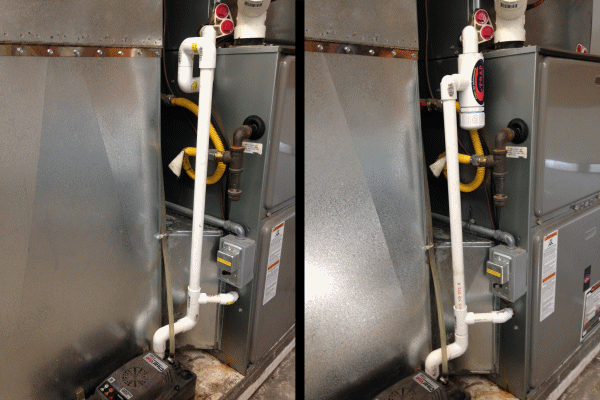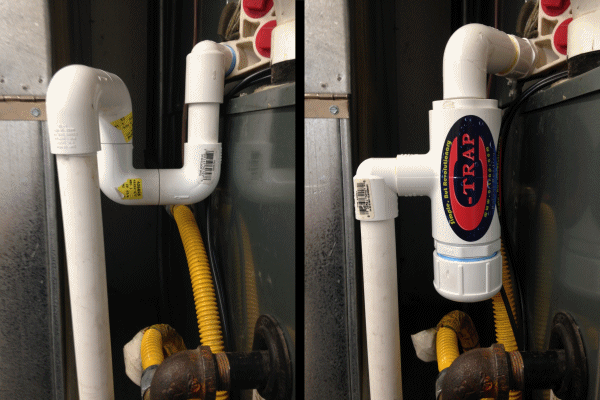The Most Practical & Efficient Trap In The Industry!
 Since the establishment of mechanical cooling of the early 1900's the necessity of containing and controlling accumulated condensation developed by such equipment has always played a critical part in the HVAC/R industry. It really goes without saying, that without it there would be as much water damage as any roof leak in a rainstorm or a leaking water pipe, sometimes even more so, because it is one of the most least thought about parts of the cooling system.
Since the establishment of mechanical cooling of the early 1900's the necessity of containing and controlling accumulated condensation developed by such equipment has always played a critical part in the HVAC/R industry. It really goes without saying, that without it there would be as much water damage as any roof leak in a rainstorm or a leaking water pipe, sometimes even more so, because it is one of the most least thought about parts of the cooling system.
A lot of people still either forget or don't realize that there's a filter in their system that needs to be changed periodically (and we all know what kind of problems that can cause). However, the condensate is even more of an oversight, because it will continue to silently do its thing... until it can't! A condensate drainage issue doesn't usually get discovered until long after the problem started and by this time a considerable amount of damage has already taken place, because a lot of condensate problems are slow developments, most damage is taking place behind the scenes before it reveals itself.
An intricate part of the condensate drainage system is the trap, and as critically necessary as a trap is, it's also equally as much of where most problems start to develop. This is because, first and foremost field made condensate traps are often constructed wrong (i.e. too big or small, drainage vents installed on the wrong side of the trap or no drainage vent on long piping runs etc.) 2 - Traps often at times trap more than just the water they collect, 3 - the water that flows through a trap is not at a high velocity and 4 – there is periodically no flow at all, with the trap holding water for long periods of time. These factors allow for slime and sludge to develop and in turn cause restrictions in the condensate drain... thus you now have a problem!
Now with all that being said, here's what I find rather interesting, as an industry-standard we continue constructing our condensate drains and field made traps out of a series 90° fittings in the same fashion as they did back in the early 1900's in spite of our ever advancing technology. The condensate drain system continues to be such an oversight that no real effort has ever been put into improving the functionality and practicality of the condensate trap. The filtration system has improved and advanced exponentially over time and yet it's the condensate drainage system that can cause the most damage. This is a sure sign of how we can all get conditioned in our traditional way of thinking even when it no longer serves our best interest.
There are only a couple of other manufactured traps on the market. However, there is nothing innovative about their design in terms of serviceability. There is no practical means of an accessible clean-out. One provides a little brush that will most likely be subject to loss or damage, which will render the device no more cleanable than any other standard condensate trap. The configuration of their design limits practical application. Meaning that they can only be installed on equipment that provides a horizontal outlet, thus it could not be readily used on or underneath equipment that possess a vertical outlet without utilizing additional pipe and fittings. Also due to it's design, it cannot be installed simply in any direction, again, without using more pipe and fittings. The very nature of C-trap's design (with the male inlet on top and a female outlet on the side) allows for a more simple and versatile application without the need of extra fittings beyond what would normally be required.
The other problem with the “current” industry standard traps is appearance and a lot of times downright cumbersome or obtrusive. Now here you have a brand new system installation that’s cost the contractor and/or customer a lot of money, it’s a good, clean, “professional install”. Except! For One Thing!... Off to the side you have this hokey looking piping configuration, which looks like something put together by a 3 year old that just raided your pipe fittings bin. There’s only on rare occasions that the “P” type trap actually looks like a professional install, but in either case there is still the problem of cumbersome or obtrusive. When these traps stick out too far they become subject to frequent damage, especially in the case of the “P” type, given the very nature of its design combined with how and where there used, are constantly getting broken off.
The pictures below display actual dimensions of C-trap compared to some of the other most common condensate traps. Also listed, is the current results of pressure resistance tests we've performed. The ratings noted next to each corresponding trap are both positive and negative static pressures (InWC) at the precise moment when blow-by occurred.
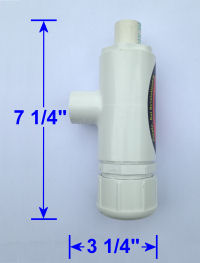 The physical size of C-trap is actually a little smaller than the amount of space generally required to accommodate any other standard traps (particularly the traditional field made series of 90°'s). In fact, one of the primary motives behind C-trap's design is compact-ability.
The physical size of C-trap is actually a little smaller than the amount of space generally required to accommodate any other standard traps (particularly the traditional field made series of 90°'s). In fact, one of the primary motives behind C-trap's design is compact-ability.
+ 3.00" w.c.
- 9.25" w.c.
In most applications it's the width 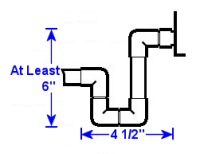 dimensions that become the most critical. The minimum space required for the field made trap is 4 1/2" in width at the very least.
dimensions that become the most critical. The minimum space required for the field made trap is 4 1/2" in width at the very least.
+ 2.90" w.c.
- 7.50" w.c.
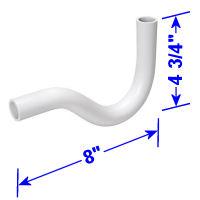 While the "P" trap design is even longer then that, at, at least 8" or more.
While the "P" trap design is even longer then that, at, at least 8" or more.
+ 1.15" w.c.
- 5.00" w.c.
As for the "SmartTrap", they offer two 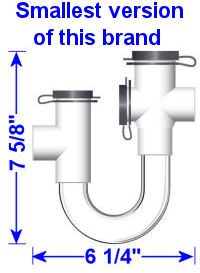 different sizes and additional pieces to use with their trap (which extends the width even further). However, the larger one being at 9 5/8" height). To use the additional piece for a vertical outlet, extends the width by another 3" at the very minimum (making it 9 1/4" in overall width).
different sizes and additional pieces to use with their trap (which extends the width even further). However, the larger one being at 9 5/8" height). To use the additional piece for a vertical outlet, extends the width by another 3" at the very minimum (making it 9 1/4" in overall width).
Pressure resistance tests have not been performed on this trap... Yet!
The other factor in the dimensions to consider is a drainage vent after the trap (which is often overlooked during a field installation), in the C-trap it’s built-in, where as all other standard traps (including "SmartTrap") it is additional time, material and space to install.
Field comparisons:
Below are a couple of actual jobs with side by side comparisons and a breakdown of time and material costs (based on local rates) for each:
Job #1:
On this job the existing condensate drain was made with CPVC material. So the material cost (on the left) is based on using the same material to re-construct an exact replacement.
Contractor’s Material Cost: 4.95 16.86
Contractor’s Time: 12.5 min. 8.5 min.
Customer’s Material Charge: 8.25 25.10
Customer’s Labor Charge: 99.00 99.00
(1 hour min.)
Total Customer Charge: 107.25 124.10

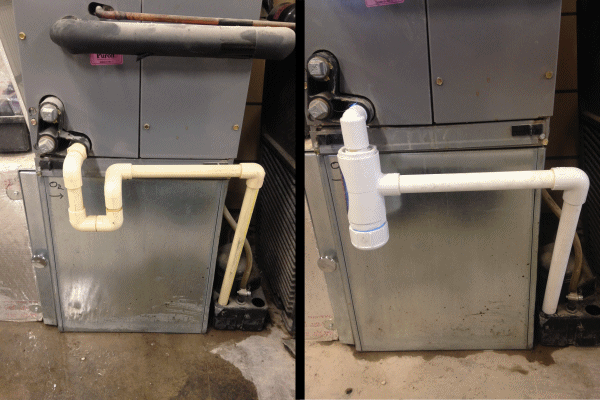

Job #2:
Contractor’s Material Cost: 5.50 19.28
Contractor’s Time: 20.0 min. 15.0 min.
Customer’s Material Charge: 9.17 32.14
Customer’s Labor Charge: 99.00 99.00
(1 hour min.)
Total Customer Charge: 108.17 131.14

